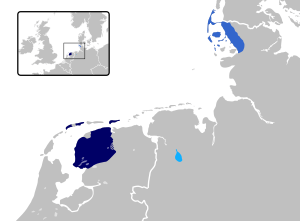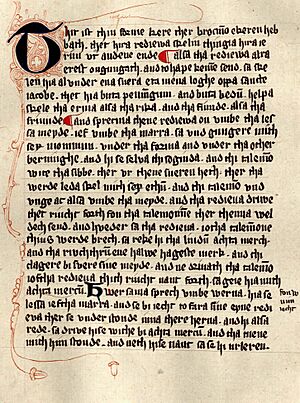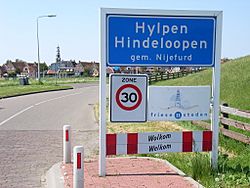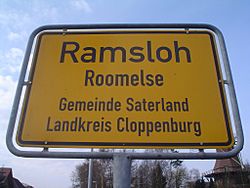Frisian languages facts for kids
Quick facts for kids Frisian |
|
|---|---|
| West Frisian: Frysk Saterland Frisian: Fräisk North Frisian: Friisk, fresk, freesk, frasch, fräisch, freesch |
|
| Ethnicity: | Frisians |
| Geographic distribution: |
Netherlands and Germany. West Frisian: Friesland, Westerkwartier; Saterland Frisian: Saterland; North Frisian: Nordfriesland, Heligoland |
| Linguistic classification: | Indo-European
|
| Subdivisions: |
West Frisian
North Frisian
East Frisian (including Saterland Frisian)
|
 Present-day distribution of the Frisian languages in Europe:
West Frisian North Frisian Saterland Frisian |
|
The Frisian languages are a group of languages spoken by about 500,000 Frisian people. These people live near the North Sea in the Netherlands and Germany. Frisian languages are part of the West Germanic languages family. This means they are related to languages like English, Dutch, and German.
Frisian languages are the closest living relatives to Anglic languages (like English). They are so close that they form a group called Anglo-Frisian languages. However, modern English and Frisian are not easy to understand for speakers of the other language. The different Frisian languages also don't understand each other well. This is because they have changed over time and have been influenced by other languages.
There are three main branches of Frisian languages:
- West Frisian
- North Frisian
- East Frisian (which now only has one living form called Saterland Frisian)
West Frisian is the most widely spoken. It is an official language in the Dutch province of Friesland. You can hear it on the mainland and on two West Frisian Islands: Terschelling and Schiermonnikoog. It is also spoken in a few villages in the nearby province of Groningen.
North Frisian is spoken in the northern part of Germany. You can find it in the Nordfriesland district in Schleswig-Holstein. It's spoken on the North Frisian mainland and islands like Sylt, Föhr, Amrum, and the Halligs. It's also spoken on Heligoland island in the North Sea.
The East Frisian branch has only one remaining language, Sater Frisian. It is spoken in the town of Saterland in Lower Saxony, Germany. This area is surrounded by bogs (wetlands). In the main region of East Frisia, people now speak East Frisian Low Saxon. This is a type of Low German, not a Frisian language.
The Frisian languages have been greatly influenced by Dutch and Low German. North Frisian also has some Danish influences. Even with these influences, Frisian is still hard for Dutch speakers to understand. For example, a study showed that Dutch people understood only about 32% of a West Frisian newspaper.
Contents
How Frisian Languages Are Divided
There are three main groups of Frisian languages: West Frisian, Saterland Frisian, and North Frisian. Some language experts think these three are just different dialects of one Frisian language. Others believe they are separate languages. Even within these groups, some dialects are not easy for speakers to understand each other.
West Frisian has been heavily influenced by Dutch. The other Frisian languages have been influenced by Low German and German. Languages like Stadsfries and West Frisian Dutch are actually Dutch dialects that have been changed by West Frisian.
The Frisian language is called Frysk in West Frisian. In Saterland Frisian, it's called Fräisk. In North Frisian, it has many names like Friisk, fresk, freesk, frasch, fräisch, and freesch.
In the Dutch province of Groningen and the German region of East Frisia, people speak Low German dialects. These dialects still have some Frisian words because Frisian used to be spoken there. Over time, Low Saxon gradually replaced Frisian. Now, these local languages are also at risk from standard Dutch and German.
Who Speaks Frisian?
Most Frisian speakers live in the Netherlands. About 400,000 people speak West Frisian in the province of Friesland. This is about 75% of the people living there. More and more Dutch speakers in Friesland are learning Frisian as a second language.
In Germany, about 2,000 people speak Saterland Frisian. They live in the Saterland area of Lower Saxony. Saterland Frisian has managed to survive, but it is still in danger. This is because there are so few speakers and not enough support to keep the language alive.
In the North Frisia region of Germany, there are about 10,000 North Frisian speakers. Many live on the mainland, but most are on islands like Sylt, Föhr, Amrum, and Heligoland. The local North Frisian dialects are still used there.
Official Status of Frisian
Saterland and North Frisian are officially recognized and protected as minority languages in Germany. West Frisian is one of the two official languages in the Netherlands, along with Dutch.
Organizations like the Ried fan de Fryske Beweging work to protect the West Frisian language and culture. The Fryske Academy also studies Frisian language, history, and society. They try to create a larger dictionary for the language.
Recently, Frisian has been used more in schools, media, and government. However, Saterland Frisian and most North Frisian dialects are still seriously endangered. West Frisian is considered vulnerable. Even with progress, there is still a lack of education and media attention for Frisian. This might be because it comes from rural areas and doesn't have as much "prestige" as other languages.
For people learning Frisian as a second language, the quality of lessons is often low. This means that Frisian classes might not help students much with their language and cultural development. Frisian also risks becoming too similar to Dutch, especially in Friesland, where both languages are used.
History of Frisian Languages
Old Frisian
In the Early Middle Ages, the Frisian lands were very large. They stretched from what is now Belgium to the Weser river in northern Germany. The Frisian language was spoken all along the southern North Sea coast. This area is sometimes called Great Frisia. Many places in this region still value their Frisian heritage, even if the Frisian languages are no longer spoken there.
Frisian is the language most closely related to English and Scots. However, after hundreds of years of influence from Dutch, modern Frisian now sounds more like Dutch than English. Also, English has changed a lot over the centuries. This means the two languages have become less similar over time. This is partly due to Dutch and Low German influencing Frisian. It's also because other languages, especially Norman French, greatly influenced English.
Old Frisian, however, was very similar to Old English. For example, both Old Frisian and Old English lost a certain sound in words like us (Frisian: ús; German: uns). Also, the Germanic 'k' sound often changed to a 'ch' sound when followed by some vowels. For example, in Frisian, cheese is tsiis and church is tsjerke. In Dutch, they are kaas and kerk.
A famous saying shows how similar Frisian and English once were: "Butter, bread and green cheese is good English and good Frisian." In West Frisian, this is "Bûter, brea en griene tsiis is goed Ingelsk en goed Frysk." It sounds very similar in both languages.
One big difference between Old Frisian and modern Frisian is that Old Frisian (around 1150 to 1550) still used grammatical cases. This means words changed their endings depending on their role in a sentence. Most texts from this time are legal writings. The oldest clear written examples of Frisian are from about the 9th century. There are also some older runic writings from the region that might be in Frisian.
Middle West Frisian
Until the 15th century, Frisian was a language that was widely spoken and written. But after 1500, it became mostly a spoken language, used mainly in the countryside. This happened partly because the Dutch province of Friesland was taken over in 1498 by Albert III, Duke of Saxony. He made Dutch the language of government instead of West Frisian.
Later, the House of Habsburg rulers continued this practice. Even when the Netherlands became independent in 1585, West Frisian did not get its official status back. This was because Holland became the most powerful part of the Netherlands. Its language, Dutch, became the main language for law, government, and religion.
During this time, the great Frisian poet Gysbert Japiks (1603–1666) was an exception. He was a schoolteacher and singer from Bolsward. He is often called the father of modern West Frisian literature and writing style.
Other writers did not follow his example until the 19th century. That's when many West Frisian authors and poets appeared. This time also saw the start of a new system of vowel changes in most West Frisian dialects. Because of this, the Modern West Frisian period is thought to have started around 1820.
Modern West Frisian
The poet Gysbert Japiks helped bring the West Frisian language back to life. He showed that it was possible to write in the language. He also helped create a shared West Frisian identity and a standard way of writing. Later, Johannes Hilarides continued Japiks' work. He focused on how West Frisian was pronounced and how common people used it every day.
Perhaps the most important person in spreading West Frisian was J. H. Halbertsma (1789–1869). He translated many works into West Frisian, including parts of the New Testament. Like Hilarides, he focused on the everyday language of West Frisian. He translated texts, plays, and songs for ordinary people. This helped teach and spread the West Frisian language. This effort to save the West Frisian language continues today.
The movement to revive West Frisian gained strength in the first half of the 20th century. It focused not only on the language but also on Frisian culture and history. People were encouraged to sing and act in West Frisian to help people speak it.
By 1960, Dutch started to become more dominant than West Frisian in Friesland. Many people who didn't speak Frisian moved to Friesland. The language slowly began to shrink. It only survives today because scholars and organizations work hard to preserve it.
In recent years, the province of Friesland itself has become a more important part of the West Frisian identity than the language. Because of this, the language has become less important for cultural preservation. Written West Frisian especially struggles to survive. Only about 30% of the West Frisian population can write it well. It stopped being used much in writing in the 16th century and is still barely taught today.
Frisian Language Family Tree
Frisian languages belong to the West Germanic branch of the Indo-European languages. This is the largest language family in Europe and the world. The closest living relatives of Frisian are the Anglic languages, which include English and Scots. Together with the related Low Saxon dialects, these groups form the North Sea Germanic languages.
- West Frisian, spoken in the Netherlands.
- Hindeloopen Frisian
- Schiermonnikoogs
- Westlauwers–Terschelling Frisian
- Terschellings (Oosterend and West-Terschelling dialects)
- Western Frisian proper
- Clay Frisian (Klaaifrysk, including Westereendersk)
- Wood Frisian (Wâldfrysk)
- South Frisian (Súdhoeks)
- East Frisian, spoken in Lower Saxony, Germany.
- Ems Frisian dialects
- Saterland Frisian
- Several extinct dialects
- Weser Frisian dialects
- Wangerooge Frisian (extinct)
- Wursten Frisian (extinct)
- Several extinct dialects
- Ems Frisian dialects
- North Frisian, spoken in Schleswig-Holstein, Germany.
- Mainland dialects
- Bökingharde Frisian
- Northern Goesharde Frisian
- Middle Goesharde Frisian
- Southern Goeshards Frisian (extinct)
- Wiedingharde Frisian
- Halligen Frisian
- Karrharde Frisian
- Island dialects
- Söl'ring
- Fering-Öömrang
- Heligolandic (Halunder)
- Extinct dialects
- Strand Frisian
- Eiderstedt Frisian
- Mainland dialects
Examples of Frisian Text
The Lord's Prayer
Here is "The Lord's Prayer" in West Frisian, compared to English and Dutch.
| The Lord's Prayer in Standard West Frisian (Frysk) from the Third Edition of the Frisian Bible | The English translation from the 1662 Anglican Book of Common Prayer | The Standard Dutch translation from the Dutch Bible Society |
|---|---|---|
|
Us Heit, dy't yn de himelen is |
Our Father, which art in Heaven |
Onze Vader die in de hemelen zijt, |
Comparing Germanic Sentences
Here are some sentences in different Germanic languages. They are not always exact translations, but they show how the languages are similar and different.
- English: English: The boy stroked the girl about the chin and kissed her on the cheeks.
- Saterland Frisian: Die Wänt strookede dät Wucht uum ju Keeuwe un oapede hier ap do Sooken.
- North Frisian (Mooring dialect): Di dreng aide dåt foomen am dåt kan än mäket har aw da siike.
- North Frisian (Söl'ring): Di Dreeng strekt dit faamen om't Ken en taatjet / kleepet höör üp di Sjaken
- West Frisian: De jonge streake it famke om it kin en tute har op 'e wangen.
- Gronings: t Jong fleerde t wicht om kinne tou en smokte heur op wange.
- East Frisian Low Saxon: De Jung (Fent) straktde dat Wicht um't Kinn to un tuutjede hör up de Wangen.
- German: German: Der Junge streichelte das Mädchen ums Kinn und küsste es (sie) auf die Wangen.
- Dutch: Dutch: De jongen aaide (streelde, streek) het meisje langs/over haar/de kin en kuste/zoende haar op de wangen.
- Afrikaans: Die seun streel die meisie oor haar/die ken en soen haar op die wange.
- Danish: Danish: Drengen strøg/aede pigen på hagen og kyssede hende på kinderne.
- Norwegian (Bokmål): Gutten strøk jenta på haken og kysset henne på kinnene.
- Norwegian (Nynorsk): Guten strauk jenta på haka og kyssa henne på kinna.
Images for kids
See also
 In Spanish: Lenguas frisonas para niños
In Spanish: Lenguas frisonas para niños






